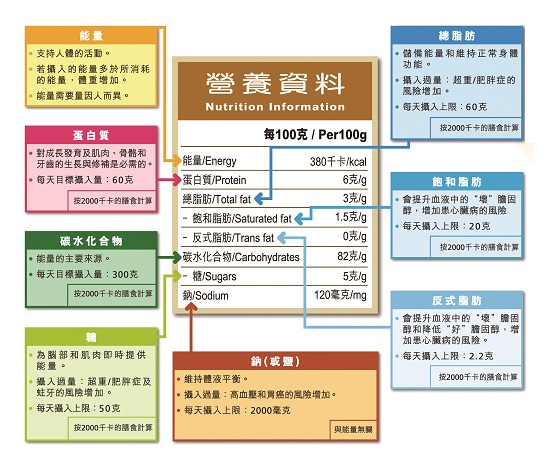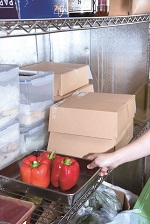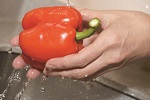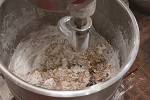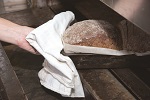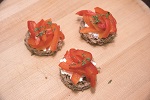
Food Safety Bulletin (4th Issue of 2016)
Feature Article
Eat Safely: Multi-tiered Seafood Steam Pot
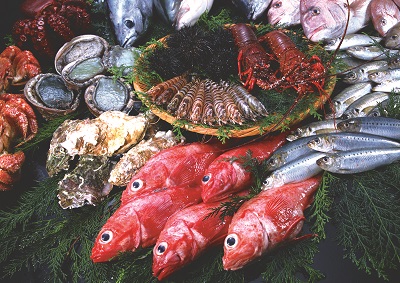
Hot pot is a winter favourite among many people in Hong Kong. How warm and convivial it is to gather around the table for a hot pot on a cold day! Unlike the conventional hot pot, the multi-tiered seafood steam pot is a new variety that has emerged in recent years. It is not only offered by eateries to attract customers, but is also prepared by many at home.
Although the hot pot and the steam pot operate on different principles, both involve plenty of raw food ingredients. If the ingredients are not properly handled or thoroughly cooked, illnesses may arise due to consumption of foods contaminated by pathogenic microorganisms. To ensure food safety, we should bear in mind the "5 Keys to Food Safety" promoted by the World Health Organization ("WHO") when preparing or eating hot pot and steam pot meals.
1. Choose
- Patronise hygienic and reliable shops for food ingredients and select fresh foods.
- See whether the container and water for holding seafood are clean. Do not buy any shellfish with an abnormal odour and non-intact shells.
- For prepackaged foods, check whether the packaging is intact. Read their expiry dates on food labels to skip expired ones.
2. Clean
- Observe good personal and food hygiene when preparing foods. Wash hands thoroughly after raw food handling to avoid cross-contamination when preparing cooked foods.
- Wash all food ingredients thoroughly. Seafood should be rinsed and sliced into thin strips for easy cooking. For shellfish, scrub the shells thoroughly and remove the internal organs.
- Before eating and handling food ingredients, wash hands thoroughly under running water with soap for 20 seconds. Then wipe hands dry.
- If there is a wound on the hand, cover it properly with a waterproof bandage or wear gloves before handling foods.
- Keep hands and utensils clean when eating.
3. Separate
- When shopping for food ingredients, buy prepackaged foods first and raw foods last.
- When buying or delivering foods, raw foods should be kept separately to prevent their juices from contaminating other foods.
- Handle raw and cooked foods carefully and separate them completely during the cooking process. Use separate sets of chopsticks and utensils with different appearances for raw and cooked foods and prevent cross-contamination by avoiding contact between raw and cooked foods on the table.
4. Cook
- Heat all food ingredients to adequate temperatures for a long enough period of time. The ingredients must be cooked thoroughly before consumption. Checking of temperature and cooking time can be easier if the steam pot is provided with a thermometer and a timer.
- As a safe way of processing foods by heat, it is generally advisable to heat foods to an internal temperature of 75°C for 30 seconds. More stringent time and temperature combinations are required in the handling of shellfish.
- Different foods require different cooking temperatures and cooking time. Therefore, food ingredients should be steamed on different tiers, depending on the food type, with those that require a shorter cooking time on the top and those that take a longer time at the bottom.
- Shrimps must not be eaten when they are only barely cooked. They should be cooked until the shells are red and the flesh is white and opaque. Avoid eating the heads.
- Cook shellfish until their shells pop open and steam them for another three to five minutes before consumption. Shellfish that do not open after cooking shall be discarded.
5. Safe temperature
- Most ingredients should be refrigerated at 4°C or below, while frozen foods should be stored in a freezer at -18°C or below.
- Do not allow frozen foods to thaw at room temperature as bacteria may multiply rapidly in foods. It is preferable to defrost frozen foods in a refrigerator or a microwave oven.
- The lowest tier of the steam pot is often used for making congee or a soup. Consume the congee (or soup) promptly after cooking. Do not leave cooked foods at room temperature for more than two hours. If cooked foods are not eaten immediately, they should be reheated fully until piping hot before serving.
The above key points are applicable to the steam pot, the hot pot and daily cooking practices as well. We must not handle foods inadvertently for the sake of saving time and trouble, otherwise foodborne pathogens will not be completely killed and food poisoning, parasitic diseases or intestinal diseases can be caused.
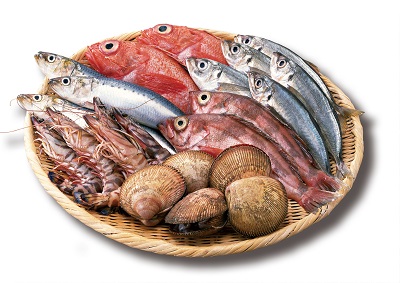
Readers' Corner
Nutrition Labelling for Healthy Eating
The Nutrition Labelling Scheme ("NLS") has been in implementation since July 2010. The NLS covers nutrition labelling and nutrition claims and is applicable to general prepackaged foods. Its aims are to assist consumers in making informed food choices, to encourage food manufacturers in applying sound nutrition principles in the formulation of food products, and to regulate misleading or deceptive labels and claims.
Nutrition labels provide nutrition information on food products with which consumers can choose foods best suited to their needs. Moreover, setting conditions for nutrition claims can standardise the meaning of various claims so that they will become trustworthy for consumers.
Nutrition Labels
We should be familiar with the slogan "For Your Health Count on the Nutrition Label 1+7". The basic information on a nutrition label is the "1+7" items, i.e. the values of energy and seven nutrients specified for labelling, namely protein, total fat, saturated fat, trans fat, carbohydrates, sugars and sodium.
Nutrition Claims
A nutrition claim is any representation which states, suggests or implies that a food has particular nutritional properties. There are three main types of nutrition claims: nutrient content claim, nutrient comparative claim and nutrient function claim. Accurate claims can serve as a quick reference for selected nutrition information. To regulate misleading or deceptive claims, the NLS requires that specified conditions must be met before making the claims.
Hong Kong's Action on Salt and Sugar Reduction - Reading Nutrition Labels
Apart from the above "1+7" slogan, many of us are probably familiar with another slogan - "Hong Kong's Action on Salt and Sugar Reduction". Excessive dietary intake of salt (sodium) or sugar can increase the risks of developing a number of illnesses, including hypertension, stroke, coronary heart disease, dental caries, overweight and obesity. To avoid these adverse health effects, the public is advised to make careful choices, read nutrition labels and nutrition claims, and choose food items with lower salt / sugar content when purchasing prepackaged foods.
Quick Facts About Reducing Salt and Sugar
The WHO has the following recommendations on daily intake of salt / sugar:

Specified conditions for n utrition labelling on salt / sugar content in food:
| Salt |
"Low sodium" or "little sodium": The food (whether solid or liquid) contains not more than 120 mg of sodium per 100 g or mL of food. |
Sugars |
"Low sugars" or "little sugars": The food (solid or liquid) contains not more than 5 g of sugars per 100 g or mL of food. |
|---|---|---|---|
|
"Very low sodium", "extremely low sodium" or "super low sodium": The food (whether solid or liquid) contains not more than 40 mg of sodium per 100 g or mL of food. |
"Zero sugars", "sugars free " or " no sugars": The food (solid or liquid) contains not more than 0.5 g of sugars per 100 g or mL of food. |
||
|
"Zero sodium", "sodium free" or "no sodium": The food (whether solid or liquid) contains not more than 5 mg of sodium per 100 g or mL of food. |
"Make Better Choices for Baby Use Nutrition Labels by Parent"
 |
 |
To better protect the health of infants and young children, the scope of legislation has been extended to cover nutritional composition of infant formula and nutrition labelling of infant formula, follow-up formula and prepackaged food for infants and young children, with effect from 13 June 2016.
Infant formula must contain energy and 33 nutrients ("1+33") in order to fulfil the nutritional composition requirements. A nutrition label showing the energy value and the content of 29 nutrients ("1+29") should also be included. As for follow-up formula, it requires the labelling of energy value and 25 nutrients ("1+25"). For prepackaged food for infants and young children, the labelling of energy value and four nutrients, as well as vitamin A and vitamin D (if added) ("1+4+2"), is required. Parents should read nutrition labels carefully when buying formula products and prepackaged foods for infants and young children in order to make informed choices meeting their babies' needs. On the other hand, food manufacturers should ensure that their products comply with the requirements on nutritional composition and nutrition labelling.
Advice to the Public
- Use nutrition labels to choose prepackaged foods with lower saturated fat, trans fat, sodium and sugars contents.
- Nutrition claims are only for quick reference. Consumers are encouraged to read the nutrition label to understand the overall nutritional property of the food product for making healthy food choices.
Get the Temperature Right
Frozen foods should be refrigerated at -18°C or below. Do not simply leave foods to defrost at room temperature. The proper ways to thaw foods include thawing:
- in a refrigerator at a temperature between 0°C and 4°C
- under cold running water
- in a microwave oven
News on New Dishes
Slow-roasted Red Bell Peppers with Cream Cheese on Pumpernickel Canape
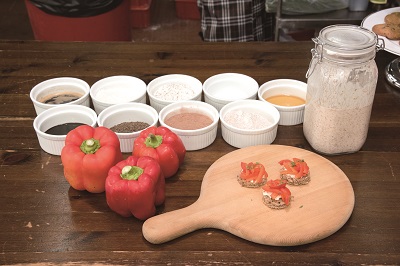
After days of hard work, the long-awaited holiday has finally come. Rather than staying idle at home, won't it be more desirable to prepare a simple snack for the upcoming festive party? In this issue, we have invited Miss Joan Yuen, the founder of "Pumpernickel" ( a signatory of the Food Safety Charter), to demonstrate for us the preparation of a healthy and refreshing vegetarian snack, namely "Slow-roasted Red Bell Peppers with Cream Cheese on Pumpernickel Canape".
| Preparation Steps | Small Tips, Big Wisdom | |
|---|---|---|
|
Receiving
|
Purchase ingredients such as flour, rye, fennel seeds, coffee powder, chocolate powder, whole wheat flour, cream cheese, red bell peppers (sweet peppers ), honey, yeast and salt from approved and reliable suppliers. | Upon receipt of the ingredients, check carefully to ensure their freshness. Keep cream cheese and red bell peppers under refrigeration at 4ºC and place the other ingredients on shelves in an orderly manner. To ensure that all foods are consumed within their expiry dates, stick to the "first-in-first-out" principle and use the oldest stocks with the shortest shelf life first. |
|
Rinsing
|
Rinse red bell peppers thoroughly. | Rinse vegetables under a running tap can effectively reduce the risk of pesticide intake. Shred vegetables to enable more even and thorough cooking. |
|
Mixing
|
Put the ingredients (except cream cheese and red peppers) in a blender, mix well for 20 to 30 minutes until the dough surface becomes glossy. | Schedule the time for preparation of ingredients to avoid starting preparations too early, thus to prevent pathogenic growth. |
|
Baking
|
Preheat the oven to 180ºC and bake the dough for 40 to 50 minutes. Set the temperature to 200ºC and roast the red bell peppers slowly for 40 minutes to an hour. Peel the peppers, cut them into strips and set aside. | Preset the time and the temperature of the oven to ensure cooking at the correct time and temperature. |
|
Preparing
|
Cut the baked bread into slices, punch rounds out with a cookie cutter and spread cream cheese over the slices. Lastly, place the baked red bell peppers on top. | Take note of the expiry date and the storage temperature of the cream cheese. The canapes should be consumed as soon as possible after preparation to avoid prolonged storage at room temperature. Don't leave any product with cream cheese on top at room temperature for more than 4 hours. Discard the product if it has been held at room temperature for a longer time. |
Tips from Miss Yuen
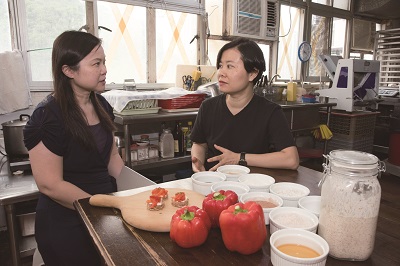
- Cream cheese should be kept under refrigeration at 4ºC or below. Take note of the expiry date and use the cheese as soon as it is unpacked.
- Clean both hands, the bench surface and other tools thoroughly before and after handling the raw dough.
Remember not to taste the raw dough or the batter when making bread to avoid possible infections by pathogens (Shiga toxin-producing Escherichia coli, etc.) that may exist in undercooked flour.
Food Safety Plan Corner
Slow-roasted Red Bell Peppers with Cream Cheese on Pumpernickel Canape
Ingredients of bread slices:
Flour, rye, whole wheat flour, fennel seeds, coffee powder, chocolate powder, honey, yeast, water and salt
Other ingredients:
Cream cheese and red bell peppers (sweet peppers)
Steps:
- Rinse the red bell peppers stored at 4°C or below thoroughly with clean water. Peel the peppers and cut them into strips.
- Take out the preferment kept under refrigeration at 4ºC. Put it and the bread ingredients in a blender and mix well for 20 to 30 minutes until the dough surface becomes glossy.
- Preheat the oven to 180ºC and bake the dough for 40 to 50 minutes.
- Set the temperature of the oven to 200ºC and roast the red bell peppers slowly for 40 minutes to an hour.
- Peel the red bell peppers, cut them into strips and set aside.
- Cut the baked bread into slices, punch rounds out with a cookie cutter and spread cream cheese over the slices.
- Lastly, place the red bell peppers on the cream cheese on top of the bread slices. Ready to serve.
Production Process
Briefing of Activities
Food Safety Talk on "Hong Kong's Action on Salt and Sugar Reduction: Healthy cooking starts small
Hong Kong people have become more health-conscious in recent years. To stay healthy, apart from doing more physical activity, we should also change our eating habits by reducing seasonings in food to avoid excessive dietary intake of salt and sugar.
To step up efforts bringing home the message and promote community involvement, the Centre for Food Safety ("CFS") chose "Hong Kong's Action on Salt and Sugar Reduction: Healthy cooking starts small" as the theme of the Food Safety Day 2016 to raise public awareness of the importance of reducing dietary intake of salt and sugar. The kick-off event was the "Food Safety Day: Junior Chefs' Culinary Ideas of Salt and Sugar Reduction Competition". Besides, a series of talks were organised by the CFS from July to December to share with the participants some simple and practical tips on reduction of salt and sugar intake in daily life and encourage children to maintain a balanced and varied diet at an early age. The meaning of "small" under "Healthy cooking starts small" is two-folded, i.e. healthy cooking starts with small actions and small children, as developing a healthy eating habit with less salt and sugar from a young age is conducive to children's healthy growth and effective prevention of chronic diseases. The Government has been promoting this message to the public through collaboration with the trade, schools and other stakeholders. At the same time, parents are encouraged to help their children grow accustomed to a light diet at an early age to reduce consumption of salt and sugar.
The CFS also took this opportunity to promote the "5 Keys to Food Safety" and introduce practical tips on proper food handling to the public with an aim to prevent foodborne diseases.
he CFS would like to express its heartfelt thanks to all attendees for their keen support.
 |
 |
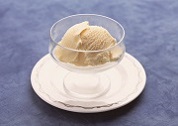 |
Upcoming Activities
Roving Exhibitions on Food Safety
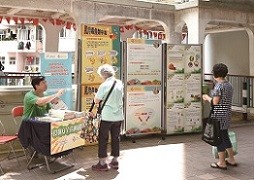 |
 |
The CFS regularly conducts thematic exhibitions in public housing estates and major shopping centres to raise food safety awareness among the public. The themes of exhibitions in 2017 include the 5 Keys to Food Safety, nutrition labelling, organic food, genetically modified food, natural toxins in food and pesticider esidues. In addition to exhibition panels, educational videos will also be shown and leaflets / souvenirs distributed at the events to enhance public knowledge on making safe and suitable food choices.
New arrangements for the exhibitions will be announced on a regular basis. Please visit the CFS website at www.cfs.gov.hk for information. Members of the public are most welcome to attend the exhibitions. For enquiries, please contact our Communication Resource Unit ("CRU") at 2381 6096.
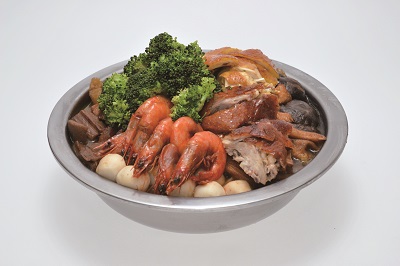
Food Safety Q&A
Is Red Fermented Rice Safe to Eat?
In late 2016, a rumour about the prohibited sale of "red rice" in the United States ("the US") went viral on local social media. It was alleged that "red rice" contained a cholesterol-lowering chemical which could affect the liver and muscles. In response to the incident, the CFS debunked the allegation on its Facebook page about the muddling of "red rice" and "red fermented rice". This article discusses the food safety of "red rice" and "red fermented rice".
What is the Difference Between "Red Fermented Rice" and "Red Rice"?
Red fermented rice is produced by fermenting rice with the fungus of the genus Monascus, most commonly Monascus purpures. Different from red rice, red fermented rice (also known as red yeast rice, monascus, hong qu and angkak) is not consumed as a staple. It has been used as a food colourant and a flavour enhancer and for meat preservation and wine brewing in Asia for centuries. Traditionally, red fermented rice is used in fermented bean curd, rice wine and some Chinese cuisines. Depending on the Monascus strains used and the fermentation conditions, various products of Monascus spp. may be formed. These include various pigments (which give the distinct colour to red fermented rice) and some pharmacologically active substances (e.g. monacolin K).
Red rice, on the other hand, is a type of whole grain rice which has a red coloured bran covering the rice kernel. According to the Food and Agriculture Organization of the United Nations, red rice is rich in fibre, B vitamins and minerals (e.g. iron, zinc), and is generally more nutritious than white rice. The World Health Organization and many other health authorities recommend including whole grains (e.g. red rice, oatmeal) as part of a balanced diet. Red rice is mixed with white rice to increase dietary fibre intake and is gaining popularity.
Is Red Fermented Rice Safe?
Red fermented rice has a long history of use as a food ingredient and a medicine. It is described as a non-poisonous product in Bencao Gangmu (《本草綱目》). However, the toxicity of red fermented rice and monascus pigments has not been evaluated by the relevant international food safety authorities. Toxicological information about red fermented rice and its pigments is limited.
Monacolin K produced during monascus fermentation is chemically identical to the active ingredients in the cholesterol-lowering drug lovastatin. Therefore, consumption of products containing monacolin K may affect blood cholesterol levels and causes the same types of side effects such as liver toxicity and muscle problems. While consumers have no way of knowing how much monacolin K is present in red fermented rice and its products, tests performed by the US Food and Drug Administration ("FDA") indicate that red fermented rice sold as a food product contains no or only traces of monacolin K.
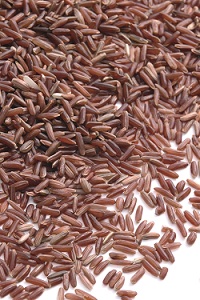
Picture of red rice
In the US, lovastatin is an active ingredient in FDA-approved drugs used to treat patients with high blood cholesterol. In 1998, the FDA determined that a red fermented rice product intended to be sold as a dietary supplement contained a substantial amount of monacolin K and was an unapproved new drug, not a dietary supplement. On several occasions since then, the FDA has taken action against companies selling red fermented rice products that contain more than trace amounts of monacolin K.
In the European Union, the European Food Safety Authority considered that the health claim "Monacolin K from red fermented rice contributes to the maintenance of normal blood cholesterol concentrations" was substantiated at daily intakes of 10 mg monacolin K from any red fermented rice preparation for adults in the general population.
Advice to the Public
- Red rice should not be confused with red fermented rice.
- Red rice can form part of a balanced diet and is safe for human consumption.
- Red fermented rice has a long history of use as a food ingredient in the Mainland, Japan and Taiwan.
- Include whole grains, such as red rice, as part of a balanced diet.
- Consult medical professionals if one intends to consume red fermented rice products for their cholesterol-lowering effect.
Truth against Fallacy
Longer Shelf Life of Foods Means Greater Use of Preservatives?
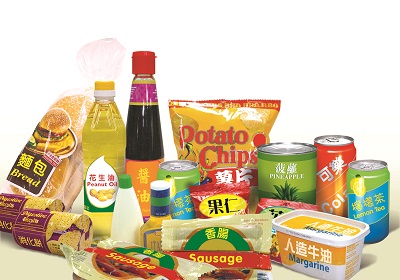
Will you check the expiry date on the food label when purchasing prepackaged foods? Have you ever doubted that foods with a longer shelf life have higher levels of preservatives?
In fact, the level of preservatives is only one of the many factors that determine the shelf life of foods. If foods are low in moisture or high (or low) in pH value, they are not prone to infection by most microorganisms such as moulds, yeasts and bacteria. These foods have a longer shelf life even without the use of preservatives.
The application of preservatives is just one of the ways to inhibit, retard or arrest the process of fermentation, acidification or deterioration of foods. Other common food preserving techniques, including ultra-high temperature treatment, drying, fermentation and salting, can also effectively reduce the count of spoilage microorganisms or inhibit their growth. Certain food packaging or storage methods such as vacuum packing or chilling / refrigeration can likewise increase the shelf life of foods.
How can the public avoid consumption of excessive preservatives from foods?
- Maintain a balanced diet in order to avoid excessive exposure to any particular preservative or chemical from a small range of food.
- Purchase foods from reliable shops.
- Refer to the list of ingredients on the packaging to find out if the food contains any additives (including preservatives) and to identify products added with preservatives. This is especially important for people susceptible to food allergies.
Brain Gym
Multiple Choice Questions
Question
Food allergy is a reaction of the body's immune system to some substances in foods . The symptoms include skin irritation, gastrointestinal disturbances, non-stop sneezing and breathing difficulty. It may even cause death in severe cases. Currently there is no cure for food allergy. The only effective way to prevent allergic reactions is to avoid foods that contain the allergen.
Food allergy sufferers have to rely on accurate food labels to choose foods. Do you know which allergens must be specified on food labels under the law? Try to identify them from the food categories below:
|
Cereals containing gluten |
Peanuts, soya beans and their products |
Meat and meat products |
Poultry meat, game and their products |
|
Ascorbic acid |
Crustacea and crustacean products |
Tree nuts and nut products |
Fish and fish products |
|
Milk and milk products |
Vegetables and mushrooms |
Sulphite |
Eggs and egg products |
Answers:
Under the Food and Drugs (Composition and Labelling) Regulations, if any of the following eight types of substances which are known to cause allergy in some individuals are found in prepackaged foods, such substance(s) should be specified in the list of ingredients.
- Cereals containing gluten (namely wheat, rye, barley, oats, spelt, their hybridized strains and their products)
- Crustacea and crustacean products
- Eggs and egg products
- Fish and fish products
- Peanuts, soyabeans and their products
- Milk and milk products (including lactose)
- Tree nuts and nut products
- Sulphite in a concentration of 10 parts per million or more
Enquiries and Subscription
Printed copies of the Food Safety Bulletin can be obtained from the CRU at 8/F, Fa Yuen Street Municipal Services Building, 123A Fa Yuen Street, Mong Kok, Kowloon. For enquiries, please call 2381 6096. The public may also visit the CFS website ( www.cfs.gov.hk ) for the online version.
Enquiry hotline 2868 0000
E-mail address enquiries@fehd.gov.hk
CFS website www.cfs.gov.hk.
